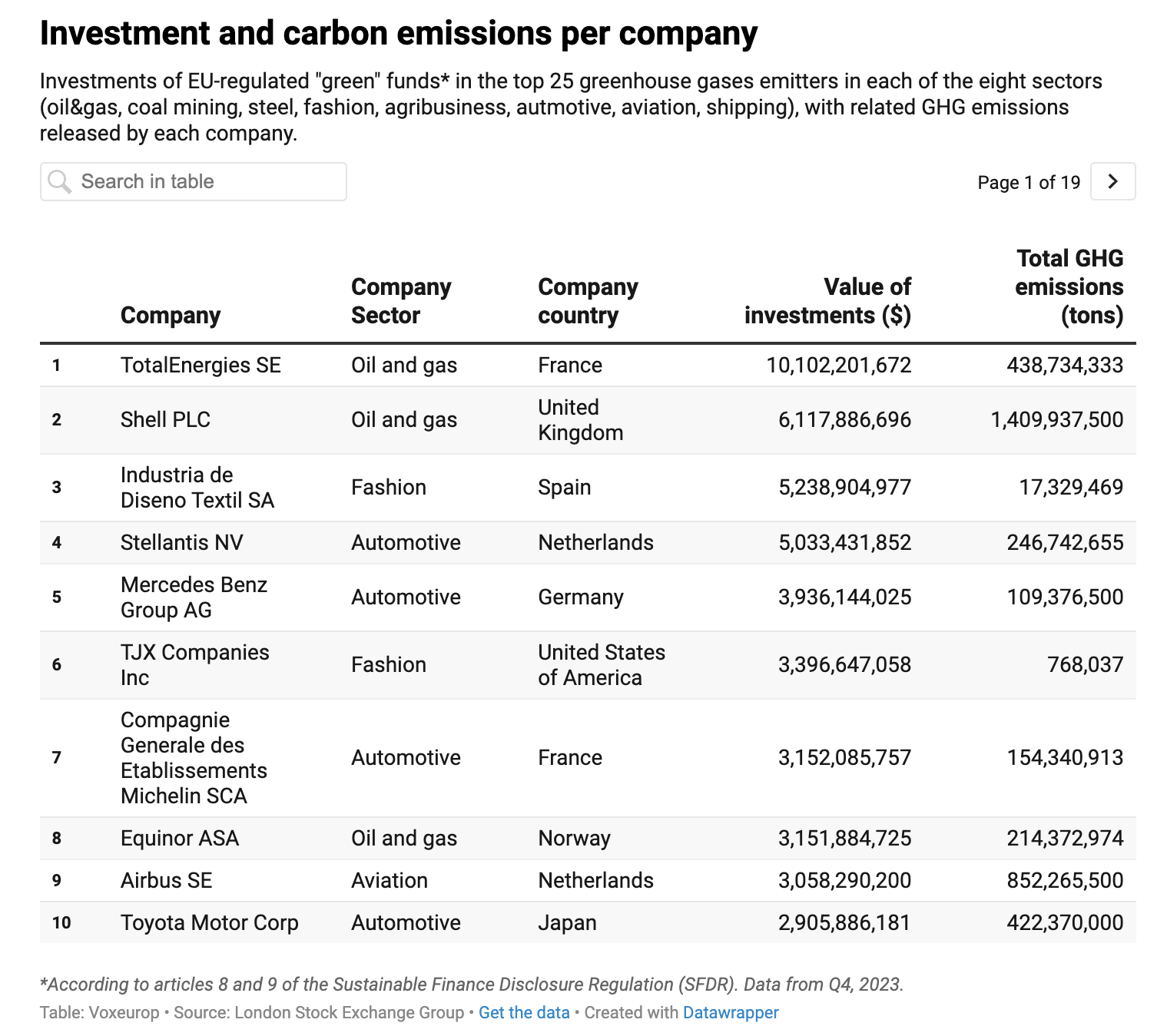Sign up for daily news updates from CleanTechnica on email. Or follow us on Google News!
Well, this was a shocker. I just saw word from Transport & Environment thanks to one of our news aggregators here that three “polluting carmakers” were among the 10 companies to receive the most European Union “green funds” investments. But even more shocking than that, another three of the top 10 companies were oil & gas companies!
This news comes from a study from Voxeurop and European Investigative Collaborations. “Oil and gas companies, carmakers and textile manufacturers make up the biggest recipients of European green funds despite being some of the world’s biggest climate polluters,” Transport & Environment writes.
“Toyota, for example, has received €3 billion from European green funds despite having a zero-emissions vehicle (ZEV) share of just 2%.” Toyota — one of the biggest anti-EV footdraggers in the world! €3 billion! As egregious as that is, though, #1 was TotalEnergies and #2 was Shell. Two oil and gas companies received more “green funds” investment than anyone else — over $10 billion in the case of the former and more than $6 billion in the case of the latter!
In fact, overall, the oil & gas sector leads for the most green funds investments. “The oil and gas sector is the most popular among these self-labelled green funds, with $33 billion invested, followed by the automotive ($22 billion) and fashion ($15 billion) sectors. The three sectors equate to 77% of all supposedly ‘green’ investments.”
Does anyone really believe these 10 companies are the companies that deserved to receive the most green funds investment? Or any green funds investments?
“Through fake ‘Planet Saver’ funds in Europe, banks are investing in some of the world’s biggest carbon emitters, driving the man-made climate crisis. These investments account for more than half of global fossil fuel emissions. At least one in five are unfairly labelled as environmentally friendly,” Voxeurop writes.
If you haven’t been forced to turn away in disgust yet, here are some more details from Transport & Environment:
“Investments promoted as ESG are required to classify as being either an Article 8 or 9 fund, according to the EU’s Sustainable Finance Disclosure Regulation. Article 8 funds are considered ‘light green’ and are supposed to promote environmental or social characteristics. Article 9 are funds that have sustainable investment as their main objective.
“The researchers analysed over 4,000 ‘green’ funds (Articles 8 and 9) in Europe from nearly 800 financial institutions. They found that 200 of the world’s most polluting companies received a total of $85 billion in investments from Article 8 funds and $2 billion from Article 9 funds.”
But, hey, what if that money is critical to or at least helping these companies be more green — that they wouldn’t be doing as much to cut emissions if they didn’t receive this money? Well, the next bit of good news from this investigation is that that’s not clearly the case.
“Stellantis has received €5 billion from European green funds with a ZEV share of just 7%, while Mercedes has received €4 billion with a ZEV share of 13%. This means the vast majority of supposedly sustainable investments in these carmakers is going towards highly carbon-intensive activities. Additionally, there is no evidence that the capital invested by asset managers covered under this investigation is guided to support these companies in their climate transition and decarbonisation.” (emphasis added)
Ah, yes, and we skipped over the aircraft company. “The inclusion of aircraft manufacturer Airbus in the top 10 recipients of green funds is also a surprise. Airbus delivered over 700 commercial aircraft in 2023. 99.4% of the fuel these planes run on today is fossil fuel.” What did Airbus do to earn this $3 billion? What has it done to cut emissions? This is a shambles. It’s a shame and a disgrace.
“As of October 2022, the Airbus A320-200 was the world’s second most popular aircraft. It accounts for 11.6 percent of aviation carbon emissions, second only to the top-seller Boeing 737-800. So how is it that producing the Airbus aeroplanes which are flying you from Paris to Helsinki, or from Dublin to Izmir, is marketed as a ‘green’ business to investors?” Voxeurop asks. “The contradiction stems from flawed legal safeguards put in place by the European Union (EU) in a loophole that allows so-called ‘green funds’ to invest in activities causing climate damage, while officially vouching for the public good.”
“Europe’s biggest green portfolios are just the same dirty companies, repackaged as sustainable,” Xavier Sol, sustainable finance director at T&E, said. “Today’s investments in Total, Toyota or Airbus cannot be considered green. We need private capital to accelerate the green transition rather than hinder it. Only investments earmarked for green activities, like zero-emission technologies, should be given a sustainable label.”
To conclude, the European organization states: “T&E recommends that the European Commission, the EU’s executive body, swiftly revises its Sustainable Finance Disclosure Regulation to prevent greenwashing in the financial sector.”
The 10 biggest “green” finance operators, based on total investment value, are the following according to the investigation:
- Deutsche Bank Asset & Wealth Management (DWS)
- Black Rock Investment Management and Advisors Divisions
- Credit Agricole Amundi Asset Management
- Intesa Sanpaolo Eurizon Capital
- Fidelity International
- JP Morgan Asset Management
- Northern Trust
- Templeton
- Allianz
- Storebrand Kapitalforvaltning.
There’s a total of 4,342 such funds, though.
“We found that the top 10 asset managers (named above) are responsible for more than a quarter of all investments by EU-regulated “green funds” — this is €87 billion — in the 25 biggest GHG emitters in each of the eight most carbon-intensive economic sectors — 200 companies in total (1). These sectors include fossil fuel extraction and refining (oil, gas and coal), agribusiness (deforestation, crop plantations, pasture, fertilisers, manure), transportation (road, aviation or shipping), steel production and fashion (2), and account for 60–70% of global carbon emissions, according to the International Panel on Climate Change (IPCC) and other sources (3).
“Our analysis shows that these 200 top GHG emitters are, on average, responsible for 77% of the emissions of all listed companies in their respective sectors.”
So, well, that’s going well. Climate investment and green funds to save the day! Yay. /s
Trying to be productive, is there a solution? Here’s the core point: “To combat greenwashing, it’s essential to align green finance laws such as the Corporate Sustainability Disclosure Directive and those under review, and ensure financial institutions provide accurate information to investors,” said Mathilde Nonnon, Sustainable Finance Policy Officer at WWF in Brussels. “We also need a clear, strict categorisation of funds with minimum criteria to ensure that investments are truly aligned with stakeholders’ desire to invest sustainably.”
Have a tip for CleanTechnica? Want to advertise? Want to suggest a guest for our CleanTech Talk podcast? Contact us here.
Latest CleanTechnica.TV Videos
CleanTechnica uses affiliate links. See our policy here.






